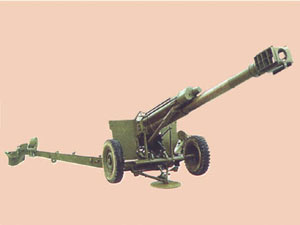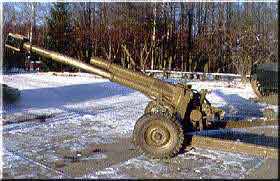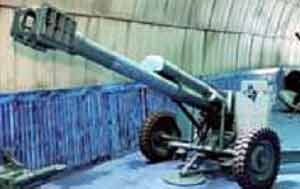| Designation: | 2B16 Nona-K |
 |
|---|---|---|
| Manufacturer: | Motovilikha Plants Corporation | |
| Product type: | Weapons & Weapon Systems | |
| Name: | Towed gun |
Designed to defeat manpower, weapons and equipment in support of the assault brigade. It is a combination breech-loading rifled-bore artillery piece capable of firing projectiles and mortar bombs from indirect and direct positions. The trails are spread automatically and closed with the help of a winch.
For some years the Russian Army deployed two 120 mm gun/mortar systems, the 2B16 (NONA-K) towed system and the 2S9 full-tracked self-propelled system. The 2S9 is based on the BMD-1 airborne combat vehicle chassis which was developed at the Izhevsk plant with production of the latter BMD-2 being undertaken at the Volgograd Tractor Plant.
It is now known that these two weapons share the same 120 mm rifled ordnance and fire the same family of ammunition with the obvious logistic and training advantages to the user.
These 120 mm weapons combine the features of a howitzer and mortar in one system. In many respects they are unique weapons as there is no similar equivalent weapon system in the West.
The 120 mm 2B16 (NONA-K) towed system was developed in the 1970s at the famous Perm artillery facility and the Central Scientific Research Institute for Precision Machinery Construction.
It was accepted for service with the Russian Army in 1986 with the main user being the Russian air assault forces.
More recently, Russia has developed a new full-tracked self-propelled artillery system called the 2S31 which fires the same family of ammunition as the 2B16, 2S9 and 2S23 as well as a complete new family of 120 mm ammunition.
The 120 mm 2S31 is based on a much-modified BMP-3 infantry combat vehicle chassis. This remains at the prototype stage and details are given in a separate entry.
UN sources have stated that Russia did not declare any export of the 120 mm 2B16 (NONA-K) for the years 1992 through to 2006.
Within the designation NONA-K the K (or Kolesnaya in Russian) stands for wheeled, with the weapon being mounted on a split trail carriage and each trail being provided with a castor wheel to assist in bringing the weapon quickly into action.
When travelling, the trails are closed together and locked and the complete upper part of the weapon is traversed through 180° and locked in position over the closed trails. This reduces the overall length of the system for travelling, which is considered important for air transport.
The 2B16 is normally towed by the GAZ-66 (4 × 4) 2,000 kg light truck which also carries the five-man crew and a quantity of ready to use 120 mm ammunition. Maximum towed speed on a good road is quoted as 80 km/h. For short distances it can be towed by the smaller UAZ-469 (4 × 4) 695 kg light vehicle.
When deployed in the firing position, the NONA-K is supported on a small circular baseplate that is located under the forward part of the carriage. The rubber-tyred road wheels are raised clear of the ground and the equipment rests on the two box-type spread trails, each of which is fitted with a spade.
The 120 mm/24.2 calibre ordnance, designated the 2A51, has 40 constant twist rifling grooves and is breech loaded. It can fire both Russian and Western natures of 120 mm rifled ammunition (for example that used by the French TDA 120 RT-61 towed mortar).
To reduce recoil forces on the barrel, a large box-type multibaffle muzzle brake is fitted which absorbs about 30 per cent of the recoil.
The hydraulic recoil system is mounted above the ordnance and extends about halfway along the barrel with the recuperator being of the hydropneumatic type. The breech mechanism is of the vertical sliding type with plastic gas obturator and a chamber indent device is fitted to retain the 120 mm projectile in place when the weapon is fired at high elevation.
The thin shield either side of the ordnance provides the crew of the 2B16 with some protection from small arms fire and shell splinters, with the left side of the shield being slightly higher than the right to protect the direct and indirect sighting system. The manual elevation and traverse controls are also on the left side of the weapon.
Types of Russian 120 mm special projectiles fired by the 2B16 include HE-FRAG (high-explosive fragmentation), HEAT (high-explosive anti-tank) and smoke as well as 120 mm mortar bombs.
The HE-FRAG projectile is called the OF-49, has a steel body and contains A-IX-2 explosive. There is also the OF-51 HE-FRAG projectile which also contains A-IX-2 explosive.
The rocket-assisted projectile is called the OF-50 with the motor cutting in 10 to 13 seconds after the projectile leaves the barrel. The HEAT projectile is fin-stabilised and will penetrate 650 mm of conventional steel armour at 90° to the vertical.
Standard 120 mm mortar bombs fired include the OF-843B, OF-34 and OF-38 high-explosive fragmentation, S-843 and 3S9 illumination, 3Z2 incendiary and 3D5 smoke. These have muzzle velocities of between 119 and 331 m/s and ranges of between 430 and 7,150 m.
The 120 mm ammunition for this as well as the 2S9, 2S23 and latest 2S31 has been designed and manufactured by the Bazalt State Research and Production Enterprise.
It has also been confirmed that the 2B16 will fire the Kitolov-2 laser-guided projectile out to a maximum range of 9 km. According to the manufacturer this has a 90 per cent hit probability on a stationary target and a 80 per cent hit probability on a moving target. Cyclic rate-of-fire is being quoted as three laser-guided rounds a minute.
The 2S9, also referred to as the NONA-S, has a similar ordnance to that used in the NONA-K but this is fitted with a system to purge the ordnance after the weapon has been fired. A pneumatically assisted rammer is fitted to increase the rate of fire and load the weapon at higher elevations. The ordnance is not fitted with a muzzle brake.
The latest 120 mm gun/mortar system to enter service is the 2S23, or NONA-SVK which is based on the chassis of the Russian BTR-80 (8 × 8) APC which has been in service with the Russian Army for some years.
This uses a modified version of the 120 mm 2A51 ordnance, which is called the 2A60, but ballistics and characteristics remain the same. Details are given in a separate entry.
|
||||||||||||||||||
|
|||||||||
 |
 |
 |
